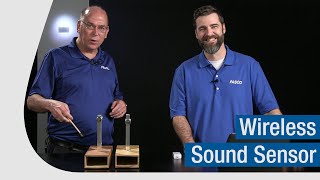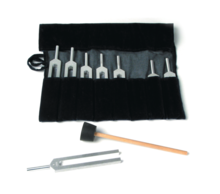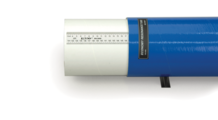The Wireless Sound Sensor measures sound wave forms and sound level in one compact and portable sensor.
- 1x USB charging cable
- 1x Threaded handle for mounting the sensor to a ring stand
See the Buying Guide for this item's required, recommended, and additional accessories.
Product Summary
The PS-3227 Wireless Sound Sensor is two sensors in one wireless package: a sound wave sensor capable of measuring relative changes in sound pressure level as a function of time, and a sound level sensor with both dBA and dBC-weighted scales.
Sound Wave Sensor: The Sound Wave Sensor measures relative changes in sound pressure level as sound waves are incident on the sensor. With graphs of the sound wave measurement versus time, students can explore and analyze wave properties like wave shape, wave speed, amplitude, frequency, wavelength, and much more. Students can use this sensor to explore superposition of waves and beat frequencies, while also exploring standing wave harmonics, and the presence of overtones. Sound wave measurements work beautifully with the scope and FFT displays in both SPARKvue and Capstone, and the Wireless Sound Sensor is capable of measuring sound wave data wirelessly at sample rates up to 100 kHz.
Sound Level Sensor: The Sound Level Sensor gives you true sound level (intensity) measurements with both dBA and dBC scales. The dBC weighting scale measures the intensity of sounds in a wide range of frequencies within, and outside the frequency range of human hearing. The dBA weighting scale filters some of the sound frequencies from a sound source to more closely match the frequency response of the human ear. The dBA scale is commonly used in the workplace to determine the sound level an employee will experience in typical working conditions. Sound level and noise pollution are key measurements in environmental science. This new sensor gives you a wireless solution to measure sound level with all the capability of a sound level meter, but adds the flexibility of recording data continuously as a function of time.
Features
- Wireless and portable
- Wirelessly measures sound wave data at high sample rates (100 kHz)
- Two sound sensors in one (sound wave and sound level)
- High quality sensing element intended specifically for laboratory experiments
- Connects seamlessly to Scope and FFT displays in both SPARKvue and PASCO Capstone software
- Threaded 1/4-20 socket for easy mounting and alignment/positioning
Applications
- Loudness, sound intensity, and the decibel scale
- Sound wave properties and characteristics
- Measure the speed of sound with an echo
- Fourier transforms and sound wave analysis
- Human ear response and frequency dependence
- Observe and measure beat frequencies
- Telephones and dial tones
- Resonance and standing waves in a closed or open pipe
What's Included
- 1x USB charging cable
- 1x Threaded handle for mounting the sensor to a ring stand
Product Specifications
| Sound Wave Sensor |
|
| Sound Level Sensor |
|
| Connectivity | USB and Bluetooth 5.2 |
| Logging | Yes |
| Battery Type | Rechargeable LiPo |
Data Collection Software
This product requires PASCO software for data collection and analysis. We recommend the following option(s). For more information on which is right for your classroom, see our Software Comparison: SPARKvue vs. Capstone »
Connectivity Options
This product can connect directly to your computer or device with the following technologies. No Interface required. See the following guide for details regarding device compatibility: Wireless Bluetooth Product Compatibility »
- Bluetooth Low Energy (BLE)
- Universal Serial Bus (USB)
Dedicated Datalogging with SPARK LXi2
Consider an all-in-one, touchscreen data collection, graphing, and analysis tool for students. Designed for use with wired and wireless sensors, the SPARK LXi2 Datalogger simultaneously accommodates up to five wireless sensors and includes two ports for blue PASPORT sensors. It features an interactive, icon-based user interface within a shock-absorbing case and arrives packaged with SPARKvue, MatchGraph!, and Spectrometry software for interactive data collection and analysis. It can additionally connect via Bluetooth to the following interfaces: AirLink, SPARKlink Air, and 550 Universal Interface.
Buying Guide
| Recommended Accessories | P/N | Price |
|---|---|---|
| Resonance Air Column | WA-9606 | -- |
| Open Speaker | WA-9900 | -- |
| Tuning Fork Technical Set | SE-7728 | -- |
| Tuning Fork Set | SE-7342 | -- |
| Wireless Sensor Charging Station Recommended charging solution for multiple sensors | PS-3599 | -- |
| Replacement Parts | P/N | Price |
|---|---|---|
| Micro USB Cable | PS-3584 | -- |
Experiment Library
Perform the following experiments and more with the Wireless Sound Sensor.
Visit PASCO's Experiment Library to view more activities.
Blockly Extension: Acoustic Stopwatch
Students develop Blockly code that uses data from a Wireless Sound Sensor to trigger start and stop timing, effectively creating a stopwatch that starts and stops using loud sound commands.
Decoding DTMF Tones
Students will use a wireless sound sensor and the fast Fourier Transform (FFT) display of the data collection software to analyze the tones produced when dialing a phone. They will uncover the pattern of these dual frequency tones...
Measuring the Speed of Sound with an Echo
Students will first predict the speed of sound in the air of their classroom using a simple relationship accounting for temperature. Students will measure the time it takes a short pulse of sound to travel the length of a tube,...
Sound of Vibrating Strings
We will explore qualitatively how string tension, length, and linear density affect the sound of the vibrating string. Then we will take measurements for the following situations:
Blockly Extension: Acoustic Stopwatch
Students develop Blockly code that uses data from a Wireless Sound Sensor to trigger start and stop timing, effectively creating a stopwatch that starts and stops using loud sound commands.
Properties of Sound Waves
Students will learn the meaning of terms (frequency, period, crest, trough, amplitude, wavelength and wave speed) used to describe waves by studying sound waves from tuning forks captured on an oscilloscope display. They will...
Wavelength, Frequency, and Wave Speed in a Guitar String
Students investigate the relationship between string length, wavelength, frequency, period, and wave speed using one of the strings on a sonometer. They use a sound sensor and FFT display to measure the frequencies produced.
Determining Sound Levels
Students learn that sound is produced by vibrating objects, that sound travels from a source through air, solids, and liquids, and its loudness on the size of its vibrations.
Waves and Energy
Students learn that sound is produced by vibrating objects, that sound travels from a source through air, solids, and liquids, and its loudness depends on the amplitude of the wave. The amplitude of the wave defines the waves...
Design a Musical Instrument
Create a musical instrument that plays the frequencies of all 8 notes of a major scale, has working parts consisting of metal bar (or tube) with lengths less than 1 m, and has a total mass of less than 5 kg.
Support Documents
| Manuals | ||
|---|---|---|
| Wireless Sound Sensor Instruction Sheet | English - 285.03 KB | |
| Safety Sheets | ||
| Lithium Battery Safety Data Sheet | English - 593.56 KB | |
| Knowledge Base | ||
| How do I troubleshoot connecting a wireless sensor? | Aug 22nd, 2022 | |
| Windows asks for a PIN number when connecting wireless sensor or device | Sep 18th, 2023 | |
| Wireless sensor or device not charging | Mar 4th, 2024 | |
| Android asks for a PIN number to pair a wireless device to system | Aug 29th, 2023 | |
| Battery replacement instructions for PS-3227 | Aug 7th, 2023 | |
| Battery warranty for rechargeable lithium ion and lithium polymer batteries | Mar 13th, 2023 | |
| Devices not shown properly in SPARKvue or PASCO Capstone | Apr 14th, 2022 | |
| Tips for use of micro USB cables | Aug 29th, 2023 | |





















